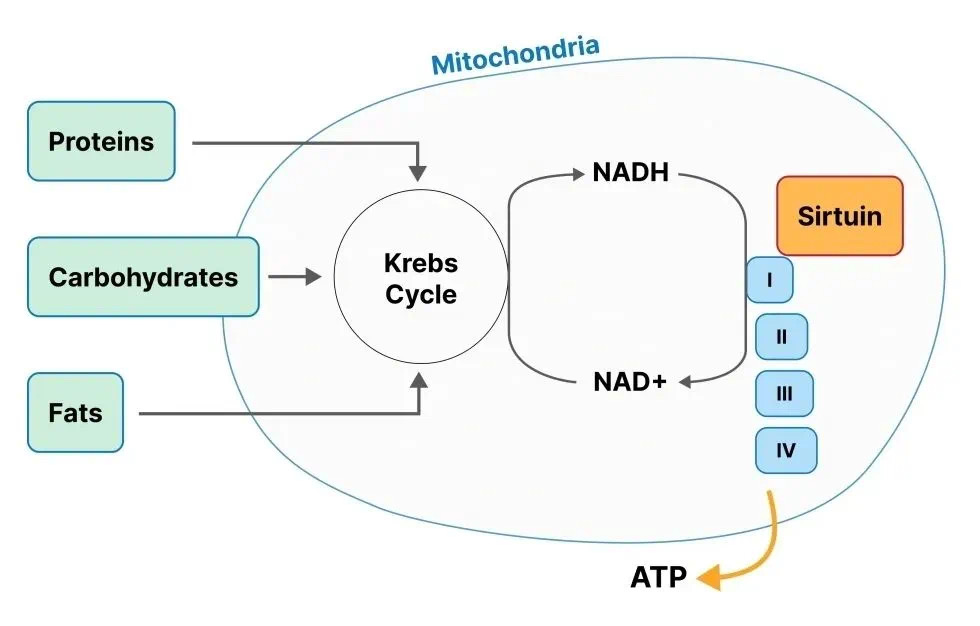

Mitochondrial Metabolism
Mitochondrial sirtuins optimize energy metabolism and sustain cellular function.
Cell metabolism is the process our cells use to convert digested food into cellular energy, ATP. Both NAD+ and sirtuin enzymes play key roles in this process. NAD+ (in the form of NADH) carries the energy from the breakdown of our food to our mitochondria, which produce the overwhelming majority of cellular ATP. The proteins involved in mitochondrial ATP production are modulated by the activity of sirtuins. Thus, when NAD+ levels are low and sirtuin activity is diminished, this process gradually collapses, leading to low ATP and other cellular catastrophes associated with aging.
Mitochondrial Dysfunction, Oxidative Stress, and Inflammation
Mitochondria are capable of producing enough ATP to meet the demands of sustaining human life. However, with aging, mitochondria become less efficient and unable to maintain adequate ATP levels. Furthermore, dysfunctional mitochondria produce high levels of reactive oxygen species (ROS), which cause damage to cells — a phenomenon known as oxidative stress. Oxidative stress is inevitably coupled with inflammation, both of which are key features of aging. Sirtuins are capable of modulating the activity of mitochondrial antioxidant enzymes to quel ROS and limit oxidative stress. Furthermore, studies have linked NAD+ depletion to mitochondrial dysfunction, which highlights the importance of replenishing NAD+ and maintaining sirtuin activity to avoid chronic oxidative stress and inflammation and the development of age-related health conditions.
Low Energy Production and Metabolic Collapse
When the food we eat is digested, it is broken down into macromolecules like proteins, carbohydrates, and fats. Once these macromolecules enter a cell, they are metabolized into ATP. However, for this conversion of macromolecules to ATP to occur, NAD+ is required. NAD+ carries the energy released from the breakdown of macromolecules by capturing electrons. In the form of NADH, NAD+ delivers electrons to mitochondria. The electrons then run through four enzyme complexes, two of which (complex I and II) are modulated by sirutins, before their energy is used to produce ATP.
NAD+ Mediates the Conversion of Macromolecules into ATP. Proteins, carbohydrates, and fats are broken down in the Krebs Cycle, where NAD+ captures energy in the form of electrons to become NADH. NADH carries the electrons to complex I of the electron transport chain, allowing for the production of ATP. Sitrutins modulate the activity of complex I (depicted) and II of the electron transport chain as well as antioxidant enzymes and other enzymes involved in cellular metabolism.
When NAD+ levels and sirtuin activity are inadequate, macromolecules can no longer be metabolized efficiently, and less ATP is produced. Without sufficient levels of ATP, our cells cannot function optimally, and eventually, apoptosis (programmed cell death) is triggered. Because our organs and tissues are made up of cells, gradual increases in apoptosis coincide with progressive tissue and organ deterioration. Over time, this deterioration leads to functional decline. For example, when apoptosis is triggered in brain cells due to low ATP levels, brain tissue begins to deteriorate, and brain function declines. This decline in brain function is what we would call cognitive decline.